Analyzing Decreasing Immunization Rates and Strategies in Australia
VerifiedAdded on 2023/06/11
|12
|3572
|138
Report
AI Summary
This report examines the decreasing rates of immunization in Australia, highlighting its status as a contemporary health issue. It discusses the reasons for the decline, including public doubts about vaccine benefits, and the potential consequences, such as increased spread of preventable diseases and strain on the healthcare system. The report focuses on the Australian government's National Immunisation Strategy for Australia 2013-2018 and the National Immunisation Program (NIP), outlining the strategy's eight strategic priorities aimed at improving immunization coverage and vaccine safety. It also addresses the barriers to implementation, such as funding limitations and growing anti-vaccination sentiments. The report concludes by emphasizing the importance of addressing these challenges to ensure the success of NIP and improve public health outcomes. Desklib provides a platform for students to access similar past papers and solved assignments for further study.
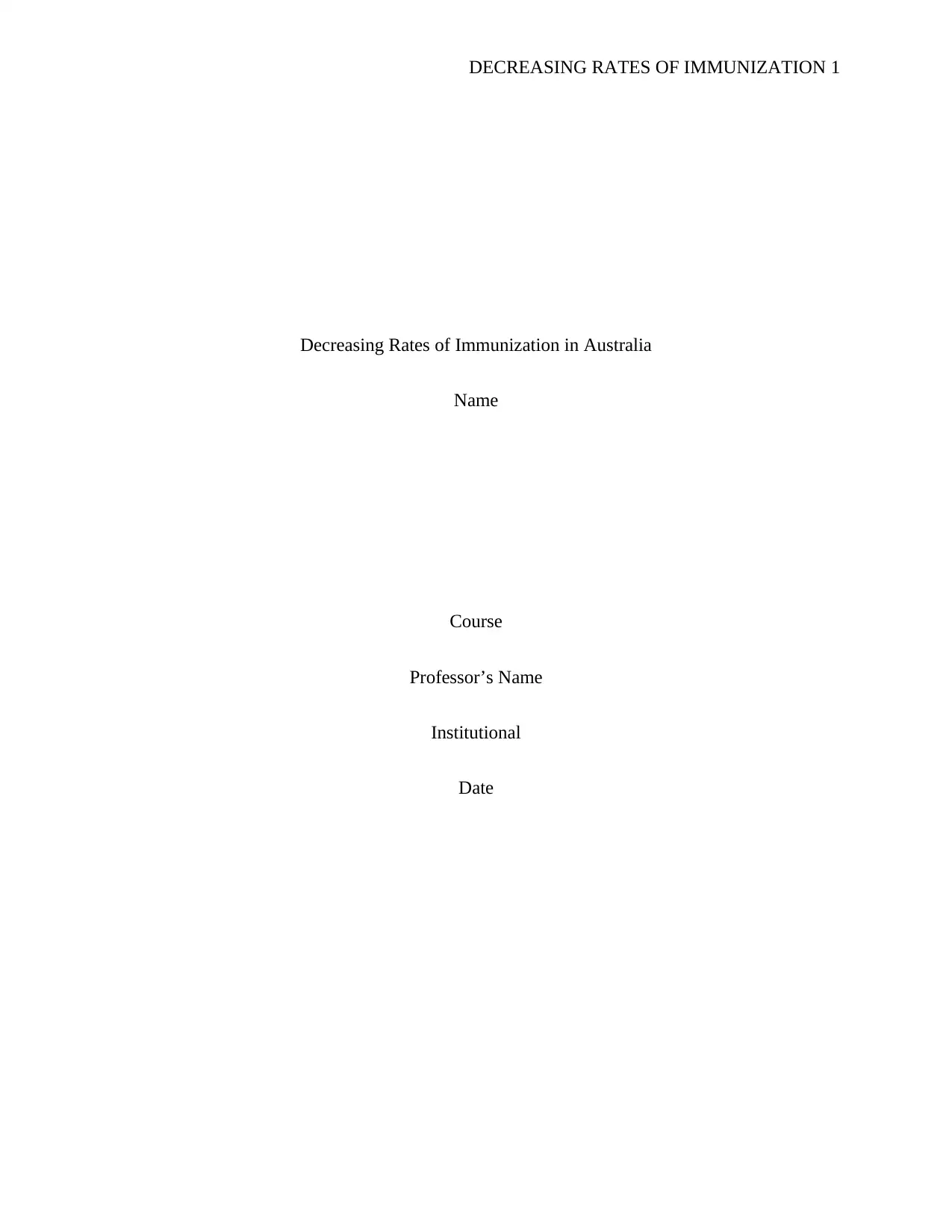
DECREASING RATES OF IMMUNIZATION 1
Decreasing Rates of Immunization in Australia
Name
Course
Professor’s Name
Institutional
Date
Decreasing Rates of Immunization in Australia
Name
Course
Professor’s Name
Institutional
Date
Paraphrase This Document
Need a fresh take? Get an instant paraphrase of this document with our AI Paraphraser
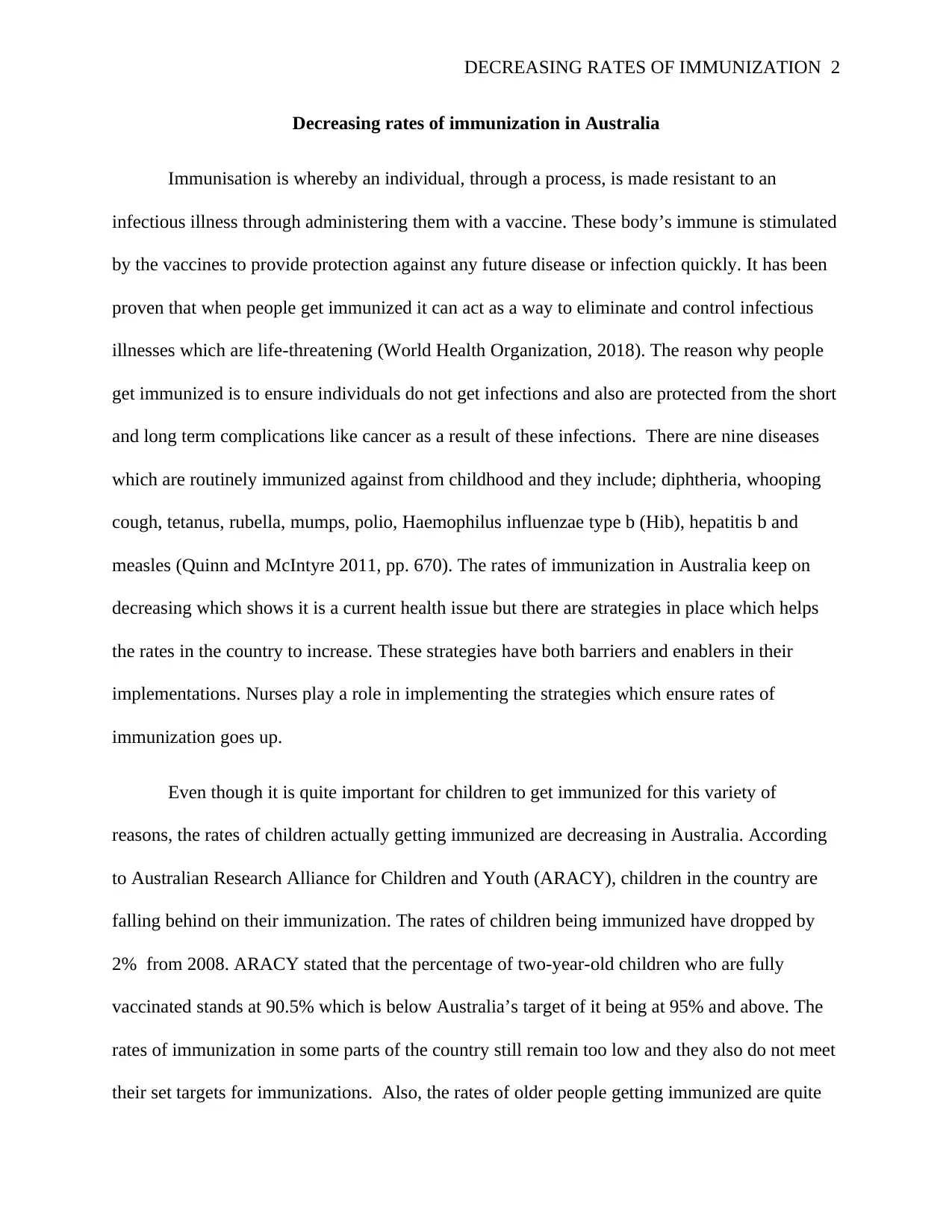
DECREASING RATES OF IMMUNIZATION 2
Decreasing rates of immunization in Australia
Immunisation is whereby an individual, through a process, is made resistant to an
infectious illness through administering them with a vaccine. These body’s immune is stimulated
by the vaccines to provide protection against any future disease or infection quickly. It has been
proven that when people get immunized it can act as a way to eliminate and control infectious
illnesses which are life-threatening (World Health Organization, 2018). The reason why people
get immunized is to ensure individuals do not get infections and also are protected from the short
and long term complications like cancer as a result of these infections. There are nine diseases
which are routinely immunized against from childhood and they include; diphtheria, whooping
cough, tetanus, rubella, mumps, polio, Haemophilus influenzae type b (Hib), hepatitis b and
measles (Quinn and McIntyre 2011, pp. 670). The rates of immunization in Australia keep on
decreasing which shows it is a current health issue but there are strategies in place which helps
the rates in the country to increase. These strategies have both barriers and enablers in their
implementations. Nurses play a role in implementing the strategies which ensure rates of
immunization goes up.
Even though it is quite important for children to get immunized for this variety of
reasons, the rates of children actually getting immunized are decreasing in Australia. According
to Australian Research Alliance for Children and Youth (ARACY), children in the country are
falling behind on their immunization. The rates of children being immunized have dropped by
2% from 2008. ARACY stated that the percentage of two-year-old children who are fully
vaccinated stands at 90.5% which is below Australia’s target of it being at 95% and above. The
rates of immunization in some parts of the country still remain too low and they also do not meet
their set targets for immunizations. Also, the rates of older people getting immunized are quite
Decreasing rates of immunization in Australia
Immunisation is whereby an individual, through a process, is made resistant to an
infectious illness through administering them with a vaccine. These body’s immune is stimulated
by the vaccines to provide protection against any future disease or infection quickly. It has been
proven that when people get immunized it can act as a way to eliminate and control infectious
illnesses which are life-threatening (World Health Organization, 2018). The reason why people
get immunized is to ensure individuals do not get infections and also are protected from the short
and long term complications like cancer as a result of these infections. There are nine diseases
which are routinely immunized against from childhood and they include; diphtheria, whooping
cough, tetanus, rubella, mumps, polio, Haemophilus influenzae type b (Hib), hepatitis b and
measles (Quinn and McIntyre 2011, pp. 670). The rates of immunization in Australia keep on
decreasing which shows it is a current health issue but there are strategies in place which helps
the rates in the country to increase. These strategies have both barriers and enablers in their
implementations. Nurses play a role in implementing the strategies which ensure rates of
immunization goes up.
Even though it is quite important for children to get immunized for this variety of
reasons, the rates of children actually getting immunized are decreasing in Australia. According
to Australian Research Alliance for Children and Youth (ARACY), children in the country are
falling behind on their immunization. The rates of children being immunized have dropped by
2% from 2008. ARACY stated that the percentage of two-year-old children who are fully
vaccinated stands at 90.5% which is below Australia’s target of it being at 95% and above. The
rates of immunization in some parts of the country still remain too low and they also do not meet
their set targets for immunizations. Also, the rates of older people getting immunized are quite
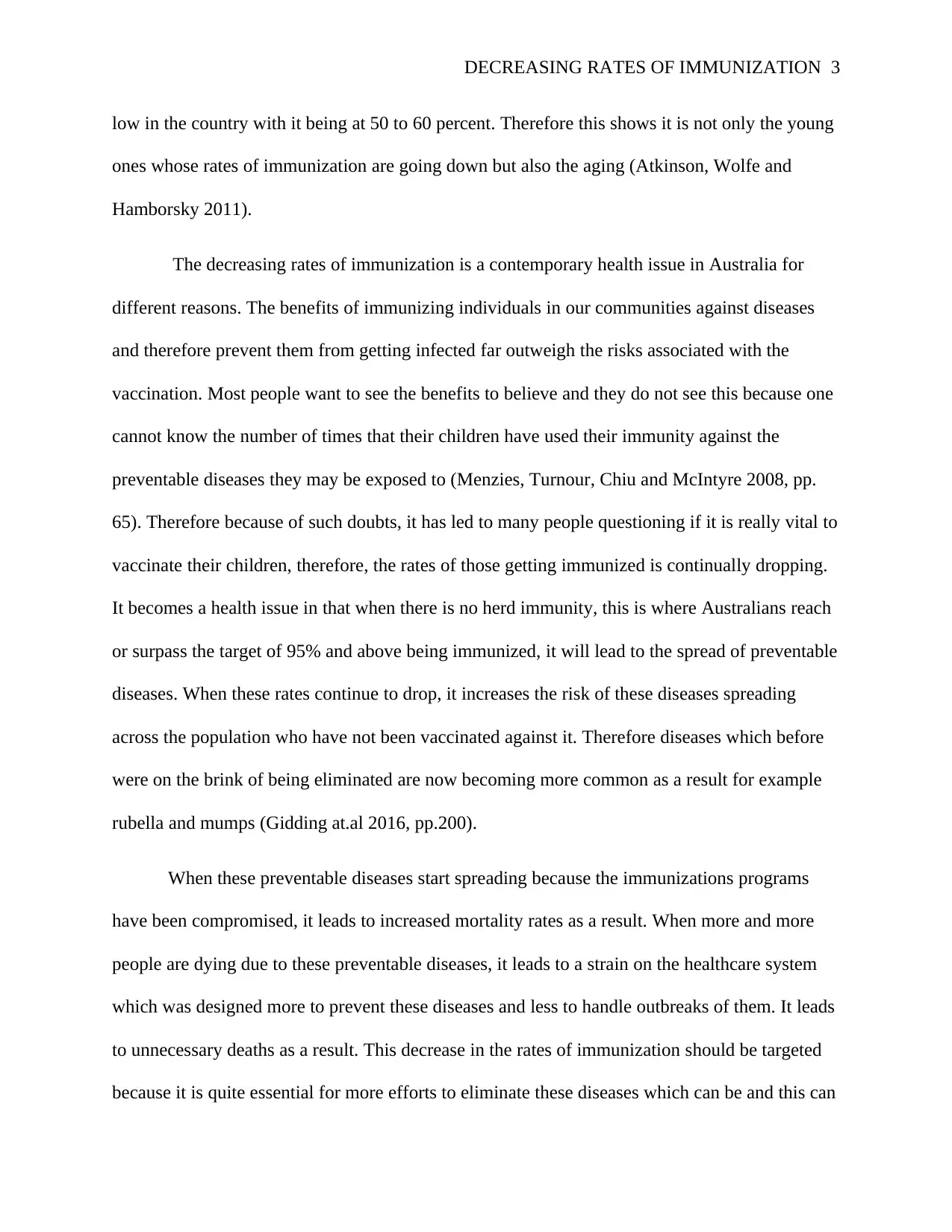
DECREASING RATES OF IMMUNIZATION 3
low in the country with it being at 50 to 60 percent. Therefore this shows it is not only the young
ones whose rates of immunization are going down but also the aging (Atkinson, Wolfe and
Hamborsky 2011).
The decreasing rates of immunization is a contemporary health issue in Australia for
different reasons. The benefits of immunizing individuals in our communities against diseases
and therefore prevent them from getting infected far outweigh the risks associated with the
vaccination. Most people want to see the benefits to believe and they do not see this because one
cannot know the number of times that their children have used their immunity against the
preventable diseases they may be exposed to (Menzies, Turnour, Chiu and McIntyre 2008, pp.
65). Therefore because of such doubts, it has led to many people questioning if it is really vital to
vaccinate their children, therefore, the rates of those getting immunized is continually dropping.
It becomes a health issue in that when there is no herd immunity, this is where Australians reach
or surpass the target of 95% and above being immunized, it will lead to the spread of preventable
diseases. When these rates continue to drop, it increases the risk of these diseases spreading
across the population who have not been vaccinated against it. Therefore diseases which before
were on the brink of being eliminated are now becoming more common as a result for example
rubella and mumps (Gidding at.al 2016, pp.200).
When these preventable diseases start spreading because the immunizations programs
have been compromised, it leads to increased mortality rates as a result. When more and more
people are dying due to these preventable diseases, it leads to a strain on the healthcare system
which was designed more to prevent these diseases and less to handle outbreaks of them. It leads
to unnecessary deaths as a result. This decrease in the rates of immunization should be targeted
because it is quite essential for more efforts to eliminate these diseases which can be and this can
low in the country with it being at 50 to 60 percent. Therefore this shows it is not only the young
ones whose rates of immunization are going down but also the aging (Atkinson, Wolfe and
Hamborsky 2011).
The decreasing rates of immunization is a contemporary health issue in Australia for
different reasons. The benefits of immunizing individuals in our communities against diseases
and therefore prevent them from getting infected far outweigh the risks associated with the
vaccination. Most people want to see the benefits to believe and they do not see this because one
cannot know the number of times that their children have used their immunity against the
preventable diseases they may be exposed to (Menzies, Turnour, Chiu and McIntyre 2008, pp.
65). Therefore because of such doubts, it has led to many people questioning if it is really vital to
vaccinate their children, therefore, the rates of those getting immunized is continually dropping.
It becomes a health issue in that when there is no herd immunity, this is where Australians reach
or surpass the target of 95% and above being immunized, it will lead to the spread of preventable
diseases. When these rates continue to drop, it increases the risk of these diseases spreading
across the population who have not been vaccinated against it. Therefore diseases which before
were on the brink of being eliminated are now becoming more common as a result for example
rubella and mumps (Gidding at.al 2016, pp.200).
When these preventable diseases start spreading because the immunizations programs
have been compromised, it leads to increased mortality rates as a result. When more and more
people are dying due to these preventable diseases, it leads to a strain on the healthcare system
which was designed more to prevent these diseases and less to handle outbreaks of them. It leads
to unnecessary deaths as a result. This decrease in the rates of immunization should be targeted
because it is quite essential for more efforts to eliminate these diseases which can be and this can
⊘ This is a preview!⊘
Do you want full access?
Subscribe today to unlock all pages.

Trusted by 1+ million students worldwide
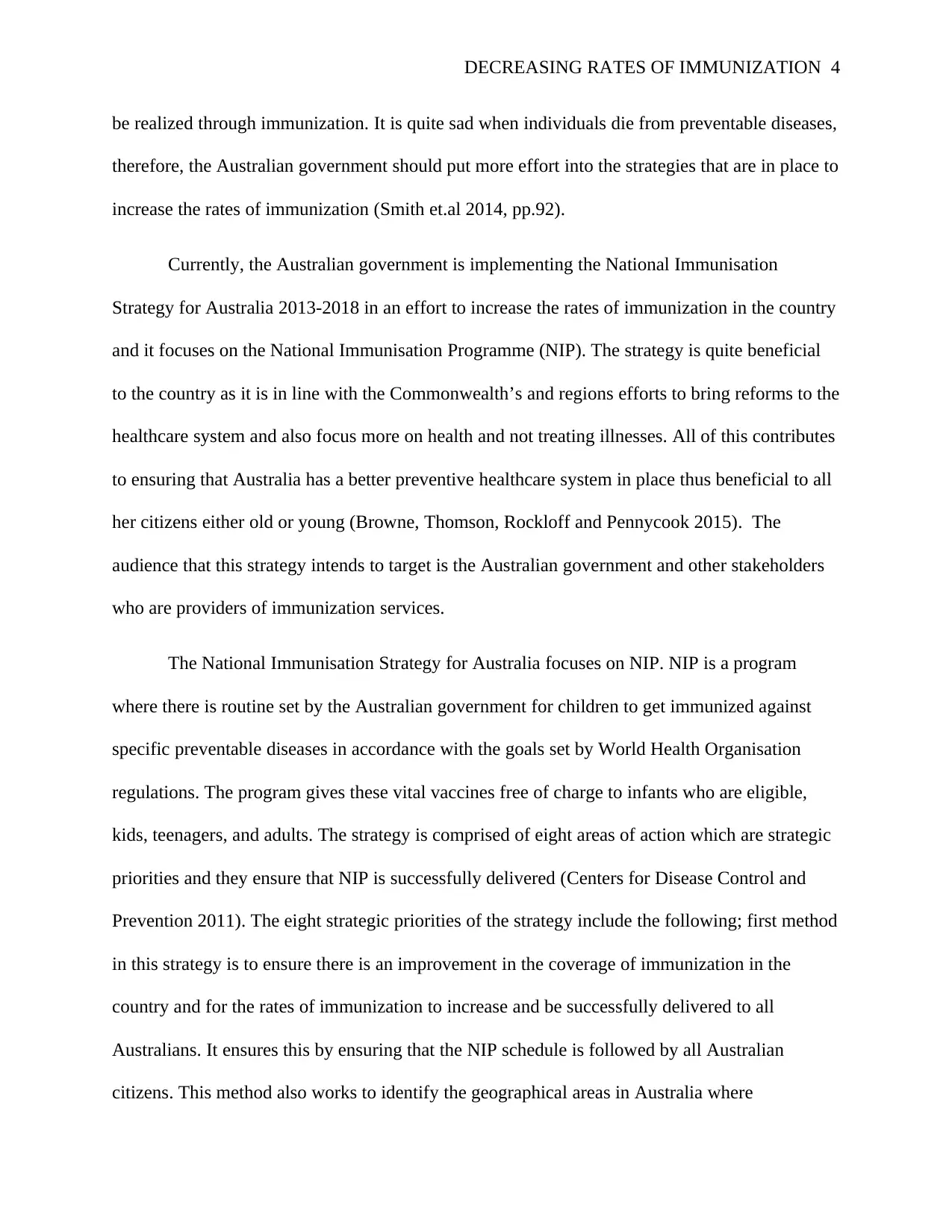
DECREASING RATES OF IMMUNIZATION 4
be realized through immunization. It is quite sad when individuals die from preventable diseases,
therefore, the Australian government should put more effort into the strategies that are in place to
increase the rates of immunization (Smith et.al 2014, pp.92).
Currently, the Australian government is implementing the National Immunisation
Strategy for Australia 2013-2018 in an effort to increase the rates of immunization in the country
and it focuses on the National Immunisation Programme (NIP). The strategy is quite beneficial
to the country as it is in line with the Commonwealth’s and regions efforts to bring reforms to the
healthcare system and also focus more on health and not treating illnesses. All of this contributes
to ensuring that Australia has a better preventive healthcare system in place thus beneficial to all
her citizens either old or young (Browne, Thomson, Rockloff and Pennycook 2015). The
audience that this strategy intends to target is the Australian government and other stakeholders
who are providers of immunization services.
The National Immunisation Strategy for Australia focuses on NIP. NIP is a program
where there is routine set by the Australian government for children to get immunized against
specific preventable diseases in accordance with the goals set by World Health Organisation
regulations. The program gives these vital vaccines free of charge to infants who are eligible,
kids, teenagers, and adults. The strategy is comprised of eight areas of action which are strategic
priorities and they ensure that NIP is successfully delivered (Centers for Disease Control and
Prevention 2011). The eight strategic priorities of the strategy include the following; first method
in this strategy is to ensure there is an improvement in the coverage of immunization in the
country and for the rates of immunization to increase and be successfully delivered to all
Australians. It ensures this by ensuring that the NIP schedule is followed by all Australian
citizens. This method also works to identify the geographical areas in Australia where
be realized through immunization. It is quite sad when individuals die from preventable diseases,
therefore, the Australian government should put more effort into the strategies that are in place to
increase the rates of immunization (Smith et.al 2014, pp.92).
Currently, the Australian government is implementing the National Immunisation
Strategy for Australia 2013-2018 in an effort to increase the rates of immunization in the country
and it focuses on the National Immunisation Programme (NIP). The strategy is quite beneficial
to the country as it is in line with the Commonwealth’s and regions efforts to bring reforms to the
healthcare system and also focus more on health and not treating illnesses. All of this contributes
to ensuring that Australia has a better preventive healthcare system in place thus beneficial to all
her citizens either old or young (Browne, Thomson, Rockloff and Pennycook 2015). The
audience that this strategy intends to target is the Australian government and other stakeholders
who are providers of immunization services.
The National Immunisation Strategy for Australia focuses on NIP. NIP is a program
where there is routine set by the Australian government for children to get immunized against
specific preventable diseases in accordance with the goals set by World Health Organisation
regulations. The program gives these vital vaccines free of charge to infants who are eligible,
kids, teenagers, and adults. The strategy is comprised of eight areas of action which are strategic
priorities and they ensure that NIP is successfully delivered (Centers for Disease Control and
Prevention 2011). The eight strategic priorities of the strategy include the following; first method
in this strategy is to ensure there is an improvement in the coverage of immunization in the
country and for the rates of immunization to increase and be successfully delivered to all
Australians. It ensures this by ensuring that the NIP schedule is followed by all Australian
citizens. This method also works to identify the geographical areas in Australia where
Paraphrase This Document
Need a fresh take? Get an instant paraphrase of this document with our AI Paraphraser
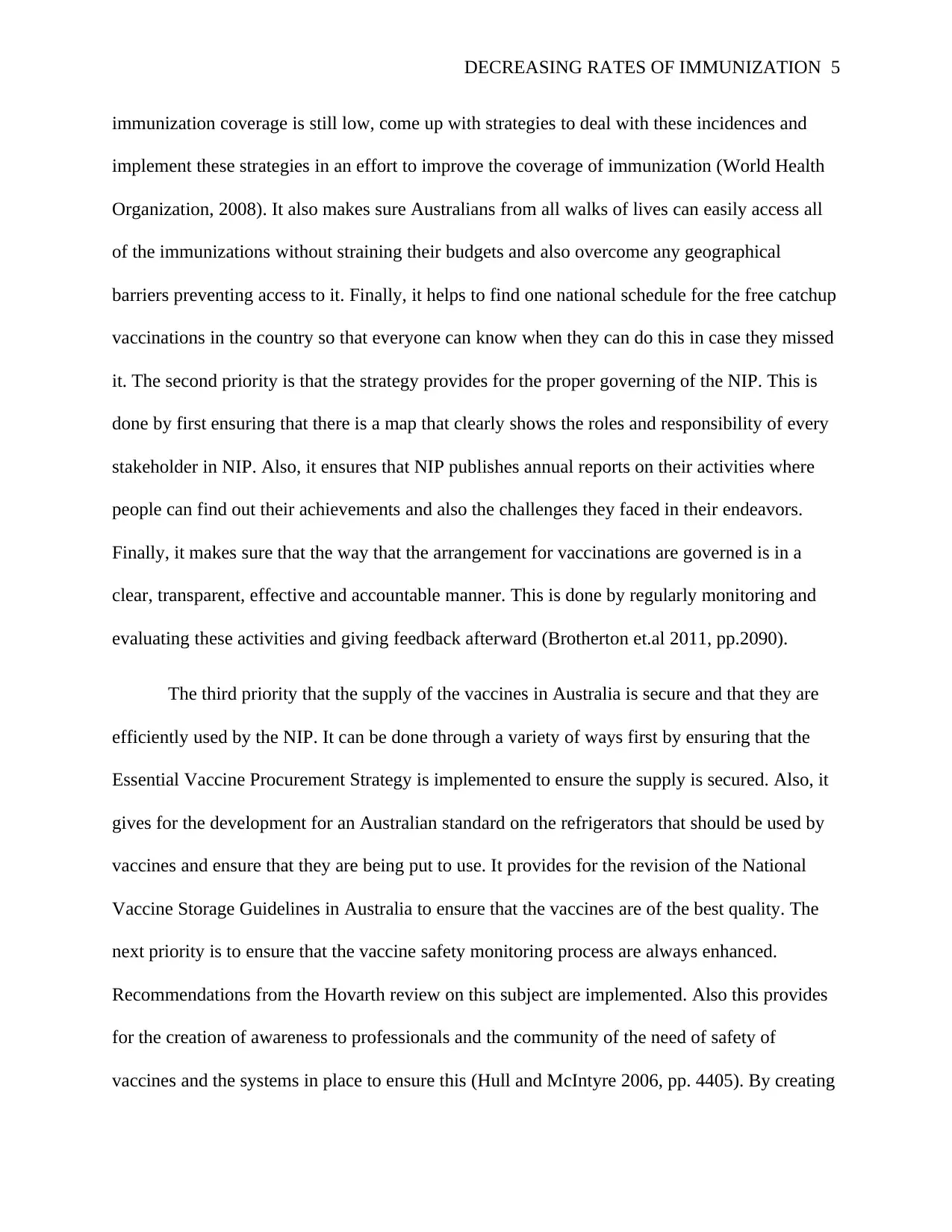
DECREASING RATES OF IMMUNIZATION 5
immunization coverage is still low, come up with strategies to deal with these incidences and
implement these strategies in an effort to improve the coverage of immunization (World Health
Organization, 2008). It also makes sure Australians from all walks of lives can easily access all
of the immunizations without straining their budgets and also overcome any geographical
barriers preventing access to it. Finally, it helps to find one national schedule for the free catchup
vaccinations in the country so that everyone can know when they can do this in case they missed
it. The second priority is that the strategy provides for the proper governing of the NIP. This is
done by first ensuring that there is a map that clearly shows the roles and responsibility of every
stakeholder in NIP. Also, it ensures that NIP publishes annual reports on their activities where
people can find out their achievements and also the challenges they faced in their endeavors.
Finally, it makes sure that the way that the arrangement for vaccinations are governed is in a
clear, transparent, effective and accountable manner. This is done by regularly monitoring and
evaluating these activities and giving feedback afterward (Brotherton et.al 2011, pp.2090).
The third priority that the supply of the vaccines in Australia is secure and that they are
efficiently used by the NIP. It can be done through a variety of ways first by ensuring that the
Essential Vaccine Procurement Strategy is implemented to ensure the supply is secured. Also, it
gives for the development for an Australian standard on the refrigerators that should be used by
vaccines and ensure that they are being put to use. It provides for the revision of the National
Vaccine Storage Guidelines in Australia to ensure that the vaccines are of the best quality. The
next priority is to ensure that the vaccine safety monitoring process are always enhanced.
Recommendations from the Hovarth review on this subject are implemented. Also this provides
for the creation of awareness to professionals and the community of the need of safety of
vaccines and the systems in place to ensure this (Hull and McIntyre 2006, pp. 4405). By creating
immunization coverage is still low, come up with strategies to deal with these incidences and
implement these strategies in an effort to improve the coverage of immunization (World Health
Organization, 2008). It also makes sure Australians from all walks of lives can easily access all
of the immunizations without straining their budgets and also overcome any geographical
barriers preventing access to it. Finally, it helps to find one national schedule for the free catchup
vaccinations in the country so that everyone can know when they can do this in case they missed
it. The second priority is that the strategy provides for the proper governing of the NIP. This is
done by first ensuring that there is a map that clearly shows the roles and responsibility of every
stakeholder in NIP. Also, it ensures that NIP publishes annual reports on their activities where
people can find out their achievements and also the challenges they faced in their endeavors.
Finally, it makes sure that the way that the arrangement for vaccinations are governed is in a
clear, transparent, effective and accountable manner. This is done by regularly monitoring and
evaluating these activities and giving feedback afterward (Brotherton et.al 2011, pp.2090).
The third priority that the supply of the vaccines in Australia is secure and that they are
efficiently used by the NIP. It can be done through a variety of ways first by ensuring that the
Essential Vaccine Procurement Strategy is implemented to ensure the supply is secured. Also, it
gives for the development for an Australian standard on the refrigerators that should be used by
vaccines and ensure that they are being put to use. It provides for the revision of the National
Vaccine Storage Guidelines in Australia to ensure that the vaccines are of the best quality. The
next priority is to ensure that the vaccine safety monitoring process are always enhanced.
Recommendations from the Hovarth review on this subject are implemented. Also this provides
for the creation of awareness to professionals and the community of the need of safety of
vaccines and the systems in place to ensure this (Hull and McIntyre 2006, pp. 4405). By creating
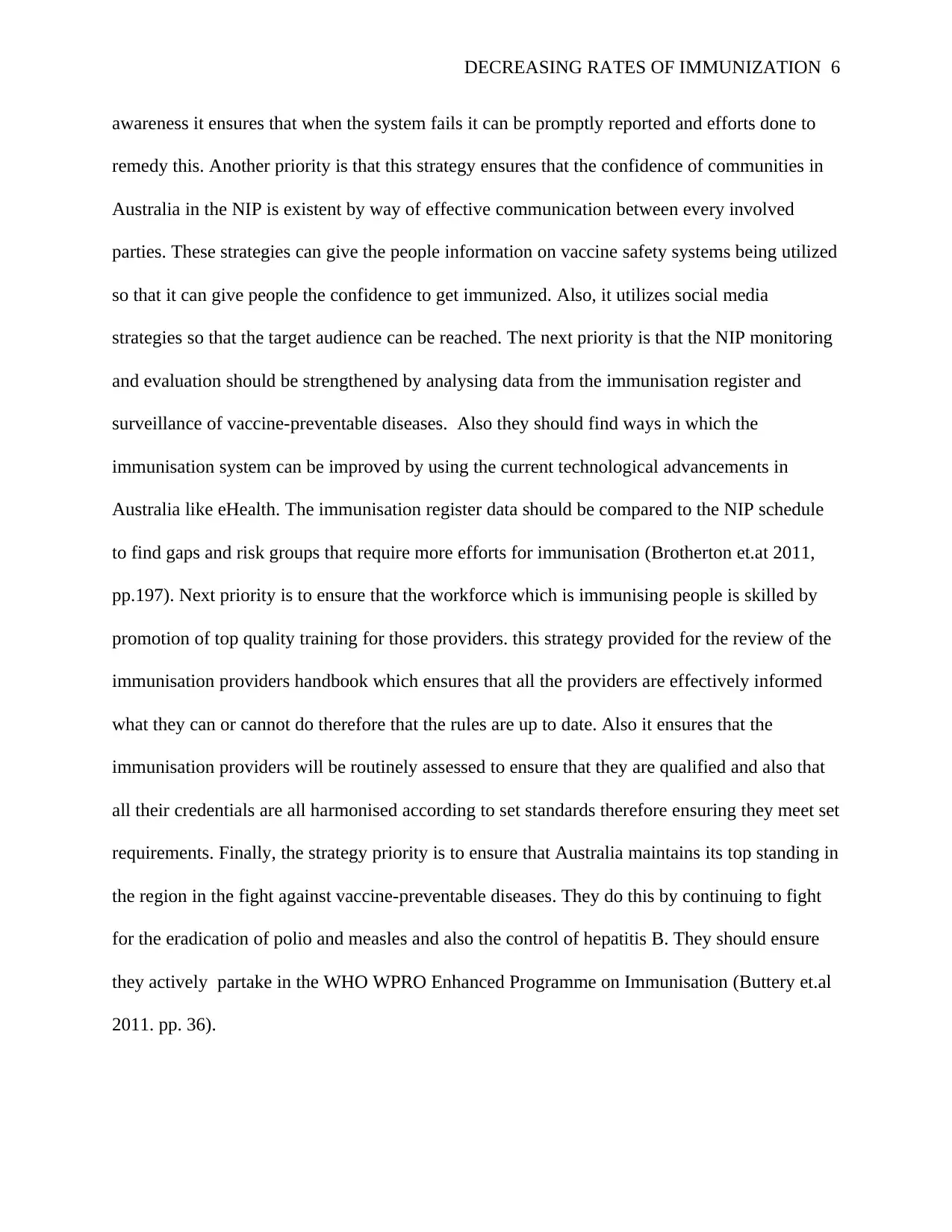
DECREASING RATES OF IMMUNIZATION 6
awareness it ensures that when the system fails it can be promptly reported and efforts done to
remedy this. Another priority is that this strategy ensures that the confidence of communities in
Australia in the NIP is existent by way of effective communication between every involved
parties. These strategies can give the people information on vaccine safety systems being utilized
so that it can give people the confidence to get immunized. Also, it utilizes social media
strategies so that the target audience can be reached. The next priority is that the NIP monitoring
and evaluation should be strengthened by analysing data from the immunisation register and
surveillance of vaccine-preventable diseases. Also they should find ways in which the
immunisation system can be improved by using the current technological advancements in
Australia like eHealth. The immunisation register data should be compared to the NIP schedule
to find gaps and risk groups that require more efforts for immunisation (Brotherton et.at 2011,
pp.197). Next priority is to ensure that the workforce which is immunising people is skilled by
promotion of top quality training for those providers. this strategy provided for the review of the
immunisation providers handbook which ensures that all the providers are effectively informed
what they can or cannot do therefore that the rules are up to date. Also it ensures that the
immunisation providers will be routinely assessed to ensure that they are qualified and also that
all their credentials are all harmonised according to set standards therefore ensuring they meet set
requirements. Finally, the strategy priority is to ensure that Australia maintains its top standing in
the region in the fight against vaccine-preventable diseases. They do this by continuing to fight
for the eradication of polio and measles and also the control of hepatitis B. They should ensure
they actively partake in the WHO WPRO Enhanced Programme on Immunisation (Buttery et.al
2011. pp. 36).
awareness it ensures that when the system fails it can be promptly reported and efforts done to
remedy this. Another priority is that this strategy ensures that the confidence of communities in
Australia in the NIP is existent by way of effective communication between every involved
parties. These strategies can give the people information on vaccine safety systems being utilized
so that it can give people the confidence to get immunized. Also, it utilizes social media
strategies so that the target audience can be reached. The next priority is that the NIP monitoring
and evaluation should be strengthened by analysing data from the immunisation register and
surveillance of vaccine-preventable diseases. Also they should find ways in which the
immunisation system can be improved by using the current technological advancements in
Australia like eHealth. The immunisation register data should be compared to the NIP schedule
to find gaps and risk groups that require more efforts for immunisation (Brotherton et.at 2011,
pp.197). Next priority is to ensure that the workforce which is immunising people is skilled by
promotion of top quality training for those providers. this strategy provided for the review of the
immunisation providers handbook which ensures that all the providers are effectively informed
what they can or cannot do therefore that the rules are up to date. Also it ensures that the
immunisation providers will be routinely assessed to ensure that they are qualified and also that
all their credentials are all harmonised according to set standards therefore ensuring they meet set
requirements. Finally, the strategy priority is to ensure that Australia maintains its top standing in
the region in the fight against vaccine-preventable diseases. They do this by continuing to fight
for the eradication of polio and measles and also the control of hepatitis B. They should ensure
they actively partake in the WHO WPRO Enhanced Programme on Immunisation (Buttery et.al
2011. pp. 36).
⊘ This is a preview!⊘
Do you want full access?
Subscribe today to unlock all pages.

Trusted by 1+ million students worldwide
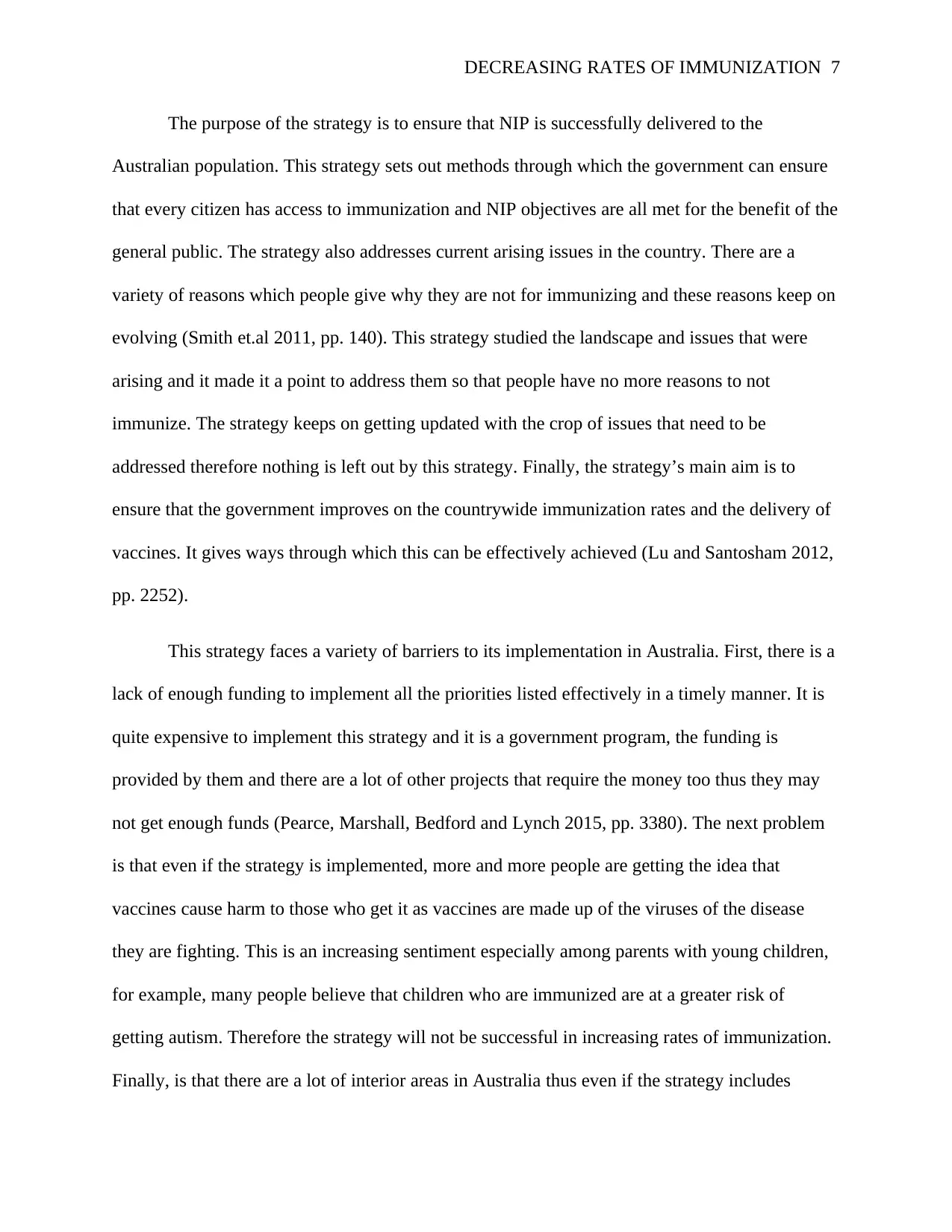
DECREASING RATES OF IMMUNIZATION 7
The purpose of the strategy is to ensure that NIP is successfully delivered to the
Australian population. This strategy sets out methods through which the government can ensure
that every citizen has access to immunization and NIP objectives are all met for the benefit of the
general public. The strategy also addresses current arising issues in the country. There are a
variety of reasons which people give why they are not for immunizing and these reasons keep on
evolving (Smith et.al 2011, pp. 140). This strategy studied the landscape and issues that were
arising and it made it a point to address them so that people have no more reasons to not
immunize. The strategy keeps on getting updated with the crop of issues that need to be
addressed therefore nothing is left out by this strategy. Finally, the strategy’s main aim is to
ensure that the government improves on the countrywide immunization rates and the delivery of
vaccines. It gives ways through which this can be effectively achieved (Lu and Santosham 2012,
pp. 2252).
This strategy faces a variety of barriers to its implementation in Australia. First, there is a
lack of enough funding to implement all the priorities listed effectively in a timely manner. It is
quite expensive to implement this strategy and it is a government program, the funding is
provided by them and there are a lot of other projects that require the money too thus they may
not get enough funds (Pearce, Marshall, Bedford and Lynch 2015, pp. 3380). The next problem
is that even if the strategy is implemented, more and more people are getting the idea that
vaccines cause harm to those who get it as vaccines are made up of the viruses of the disease
they are fighting. This is an increasing sentiment especially among parents with young children,
for example, many people believe that children who are immunized are at a greater risk of
getting autism. Therefore the strategy will not be successful in increasing rates of immunization.
Finally, is that there are a lot of interior areas in Australia thus even if the strategy includes
The purpose of the strategy is to ensure that NIP is successfully delivered to the
Australian population. This strategy sets out methods through which the government can ensure
that every citizen has access to immunization and NIP objectives are all met for the benefit of the
general public. The strategy also addresses current arising issues in the country. There are a
variety of reasons which people give why they are not for immunizing and these reasons keep on
evolving (Smith et.al 2011, pp. 140). This strategy studied the landscape and issues that were
arising and it made it a point to address them so that people have no more reasons to not
immunize. The strategy keeps on getting updated with the crop of issues that need to be
addressed therefore nothing is left out by this strategy. Finally, the strategy’s main aim is to
ensure that the government improves on the countrywide immunization rates and the delivery of
vaccines. It gives ways through which this can be effectively achieved (Lu and Santosham 2012,
pp. 2252).
This strategy faces a variety of barriers to its implementation in Australia. First, there is a
lack of enough funding to implement all the priorities listed effectively in a timely manner. It is
quite expensive to implement this strategy and it is a government program, the funding is
provided by them and there are a lot of other projects that require the money too thus they may
not get enough funds (Pearce, Marshall, Bedford and Lynch 2015, pp. 3380). The next problem
is that even if the strategy is implemented, more and more people are getting the idea that
vaccines cause harm to those who get it as vaccines are made up of the viruses of the disease
they are fighting. This is an increasing sentiment especially among parents with young children,
for example, many people believe that children who are immunized are at a greater risk of
getting autism. Therefore the strategy will not be successful in increasing rates of immunization.
Finally, is that there are a lot of interior areas in Australia thus even if the strategy includes
Paraphrase This Document
Need a fresh take? Get an instant paraphrase of this document with our AI Paraphraser
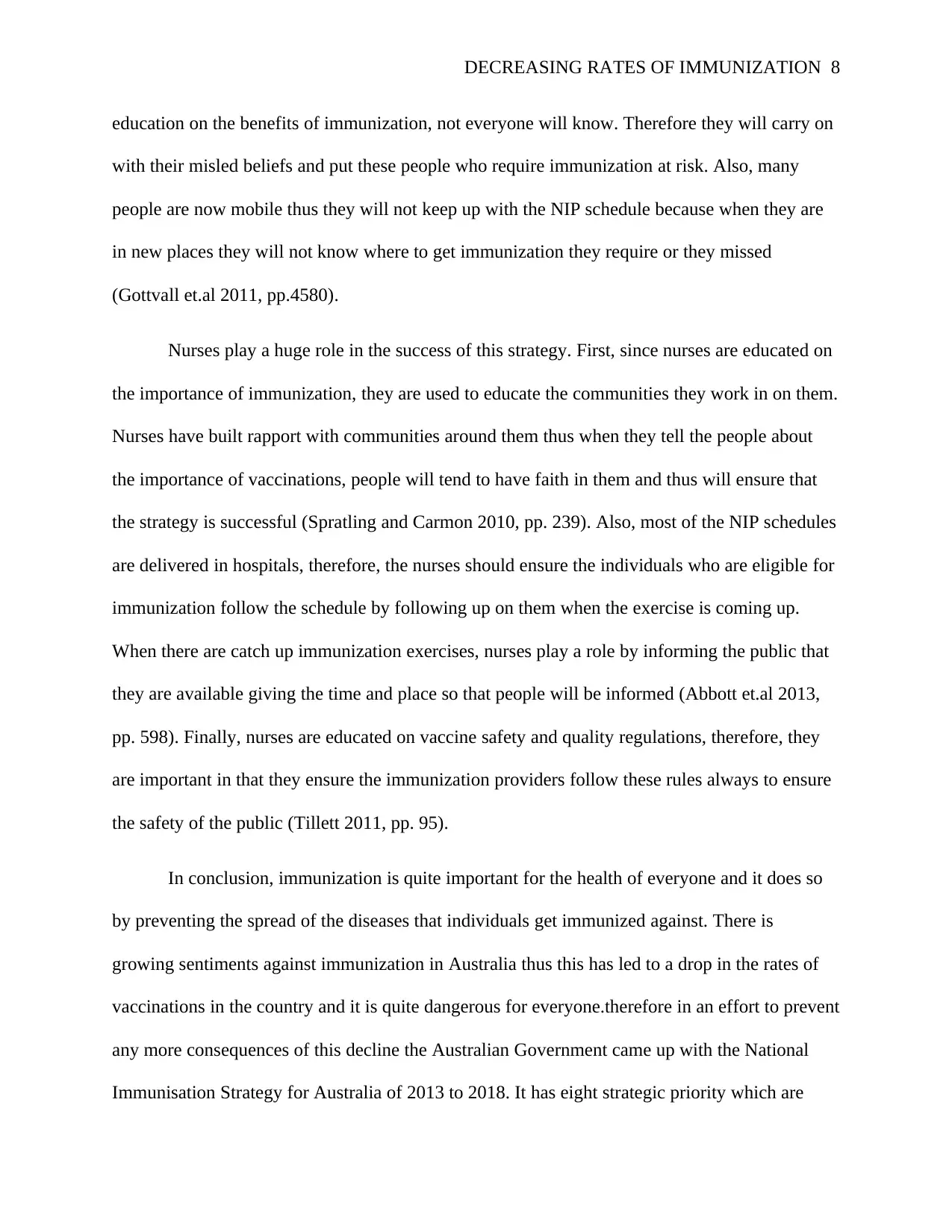
DECREASING RATES OF IMMUNIZATION 8
education on the benefits of immunization, not everyone will know. Therefore they will carry on
with their misled beliefs and put these people who require immunization at risk. Also, many
people are now mobile thus they will not keep up with the NIP schedule because when they are
in new places they will not know where to get immunization they require or they missed
(Gottvall et.al 2011, pp.4580).
Nurses play a huge role in the success of this strategy. First, since nurses are educated on
the importance of immunization, they are used to educate the communities they work in on them.
Nurses have built rapport with communities around them thus when they tell the people about
the importance of vaccinations, people will tend to have faith in them and thus will ensure that
the strategy is successful (Spratling and Carmon 2010, pp. 239). Also, most of the NIP schedules
are delivered in hospitals, therefore, the nurses should ensure the individuals who are eligible for
immunization follow the schedule by following up on them when the exercise is coming up.
When there are catch up immunization exercises, nurses play a role by informing the public that
they are available giving the time and place so that people will be informed (Abbott et.al 2013,
pp. 598). Finally, nurses are educated on vaccine safety and quality regulations, therefore, they
are important in that they ensure the immunization providers follow these rules always to ensure
the safety of the public (Tillett 2011, pp. 95).
In conclusion, immunization is quite important for the health of everyone and it does so
by preventing the spread of the diseases that individuals get immunized against. There is
growing sentiments against immunization in Australia thus this has led to a drop in the rates of
vaccinations in the country and it is quite dangerous for everyone.therefore in an effort to prevent
any more consequences of this decline the Australian Government came up with the National
Immunisation Strategy for Australia of 2013 to 2018. It has eight strategic priority which are
education on the benefits of immunization, not everyone will know. Therefore they will carry on
with their misled beliefs and put these people who require immunization at risk. Also, many
people are now mobile thus they will not keep up with the NIP schedule because when they are
in new places they will not know where to get immunization they require or they missed
(Gottvall et.al 2011, pp.4580).
Nurses play a huge role in the success of this strategy. First, since nurses are educated on
the importance of immunization, they are used to educate the communities they work in on them.
Nurses have built rapport with communities around them thus when they tell the people about
the importance of vaccinations, people will tend to have faith in them and thus will ensure that
the strategy is successful (Spratling and Carmon 2010, pp. 239). Also, most of the NIP schedules
are delivered in hospitals, therefore, the nurses should ensure the individuals who are eligible for
immunization follow the schedule by following up on them when the exercise is coming up.
When there are catch up immunization exercises, nurses play a role by informing the public that
they are available giving the time and place so that people will be informed (Abbott et.al 2013,
pp. 598). Finally, nurses are educated on vaccine safety and quality regulations, therefore, they
are important in that they ensure the immunization providers follow these rules always to ensure
the safety of the public (Tillett 2011, pp. 95).
In conclusion, immunization is quite important for the health of everyone and it does so
by preventing the spread of the diseases that individuals get immunized against. There is
growing sentiments against immunization in Australia thus this has led to a drop in the rates of
vaccinations in the country and it is quite dangerous for everyone.therefore in an effort to prevent
any more consequences of this decline the Australian Government came up with the National
Immunisation Strategy for Australia of 2013 to 2018. It has eight strategic priority which are

DECREASING RATES OF IMMUNIZATION 9
aimed at improving the rates of immunization in the country. However, it faces a variety of
challenges which need to be addressed for the success of the strategy. The people who play a
huge role in the implementation of this strategy are nurses as evidenced in the essay.
aimed at improving the rates of immunization in the country. However, it faces a variety of
challenges which need to be addressed for the success of the strategy. The people who play a
huge role in the implementation of this strategy are nurses as evidenced in the essay.
⊘ This is a preview!⊘
Do you want full access?
Subscribe today to unlock all pages.

Trusted by 1+ million students worldwide
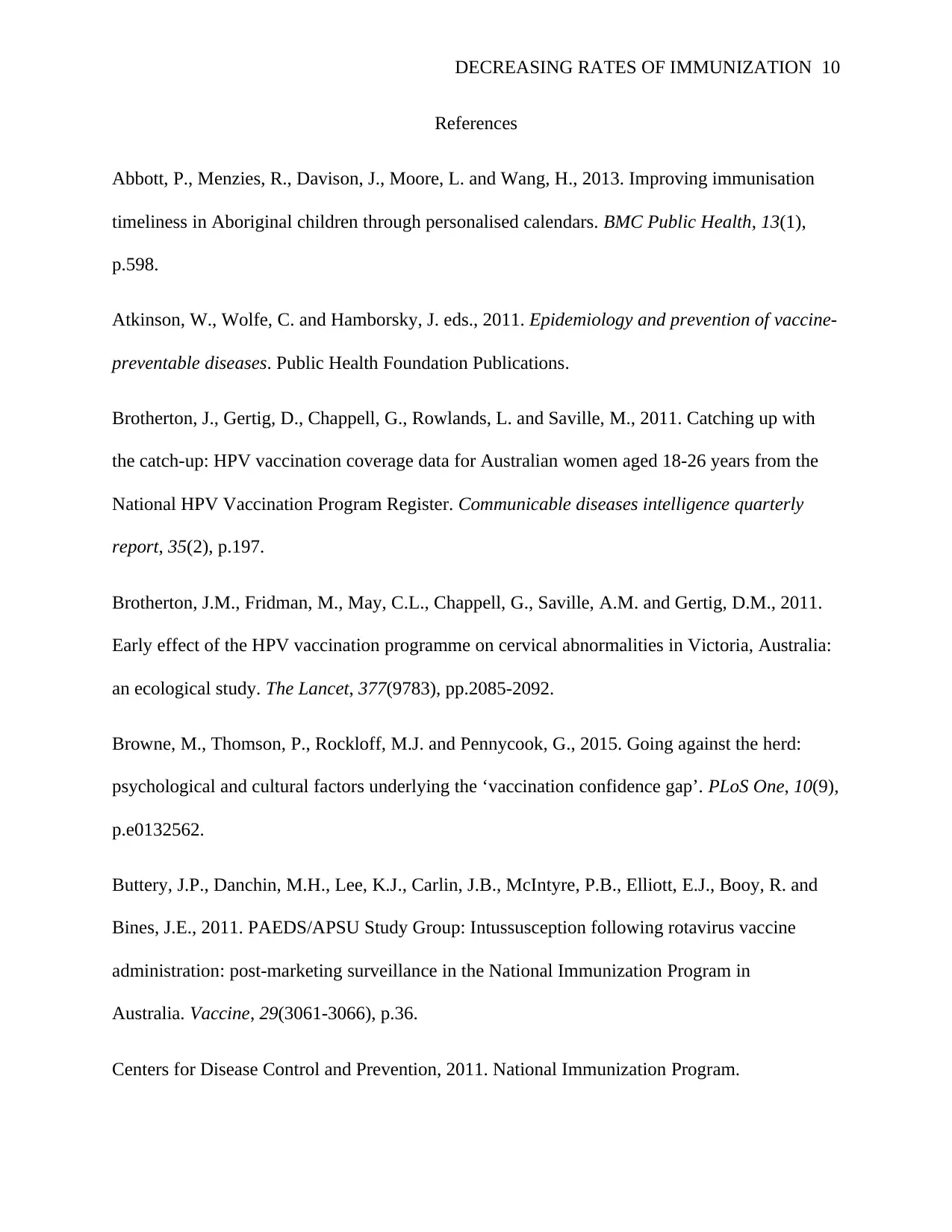
DECREASING RATES OF IMMUNIZATION 10
References
Abbott, P., Menzies, R., Davison, J., Moore, L. and Wang, H., 2013. Improving immunisation
timeliness in Aboriginal children through personalised calendars. BMC Public Health, 13(1),
p.598.
Atkinson, W., Wolfe, C. and Hamborsky, J. eds., 2011. Epidemiology and prevention of vaccine-
preventable diseases. Public Health Foundation Publications.
Brotherton, J., Gertig, D., Chappell, G., Rowlands, L. and Saville, M., 2011. Catching up with
the catch-up: HPV vaccination coverage data for Australian women aged 18-26 years from the
National HPV Vaccination Program Register. Communicable diseases intelligence quarterly
report, 35(2), p.197.
Brotherton, J.M., Fridman, M., May, C.L., Chappell, G., Saville, A.M. and Gertig, D.M., 2011.
Early effect of the HPV vaccination programme on cervical abnormalities in Victoria, Australia:
an ecological study. The Lancet, 377(9783), pp.2085-2092.
Browne, M., Thomson, P., Rockloff, M.J. and Pennycook, G., 2015. Going against the herd:
psychological and cultural factors underlying the ‘vaccination confidence gap’. PLoS One, 10(9),
p.e0132562.
Buttery, J.P., Danchin, M.H., Lee, K.J., Carlin, J.B., McIntyre, P.B., Elliott, E.J., Booy, R. and
Bines, J.E., 2011. PAEDS/APSU Study Group: Intussusception following rotavirus vaccine
administration: post-marketing surveillance in the National Immunization Program in
Australia. Vaccine, 29(3061-3066), p.36.
Centers for Disease Control and Prevention, 2011. National Immunization Program.
References
Abbott, P., Menzies, R., Davison, J., Moore, L. and Wang, H., 2013. Improving immunisation
timeliness in Aboriginal children through personalised calendars. BMC Public Health, 13(1),
p.598.
Atkinson, W., Wolfe, C. and Hamborsky, J. eds., 2011. Epidemiology and prevention of vaccine-
preventable diseases. Public Health Foundation Publications.
Brotherton, J., Gertig, D., Chappell, G., Rowlands, L. and Saville, M., 2011. Catching up with
the catch-up: HPV vaccination coverage data for Australian women aged 18-26 years from the
National HPV Vaccination Program Register. Communicable diseases intelligence quarterly
report, 35(2), p.197.
Brotherton, J.M., Fridman, M., May, C.L., Chappell, G., Saville, A.M. and Gertig, D.M., 2011.
Early effect of the HPV vaccination programme on cervical abnormalities in Victoria, Australia:
an ecological study. The Lancet, 377(9783), pp.2085-2092.
Browne, M., Thomson, P., Rockloff, M.J. and Pennycook, G., 2015. Going against the herd:
psychological and cultural factors underlying the ‘vaccination confidence gap’. PLoS One, 10(9),
p.e0132562.
Buttery, J.P., Danchin, M.H., Lee, K.J., Carlin, J.B., McIntyre, P.B., Elliott, E.J., Booy, R. and
Bines, J.E., 2011. PAEDS/APSU Study Group: Intussusception following rotavirus vaccine
administration: post-marketing surveillance in the National Immunization Program in
Australia. Vaccine, 29(3061-3066), p.36.
Centers for Disease Control and Prevention, 2011. National Immunization Program.
Paraphrase This Document
Need a fresh take? Get an instant paraphrase of this document with our AI Paraphraser
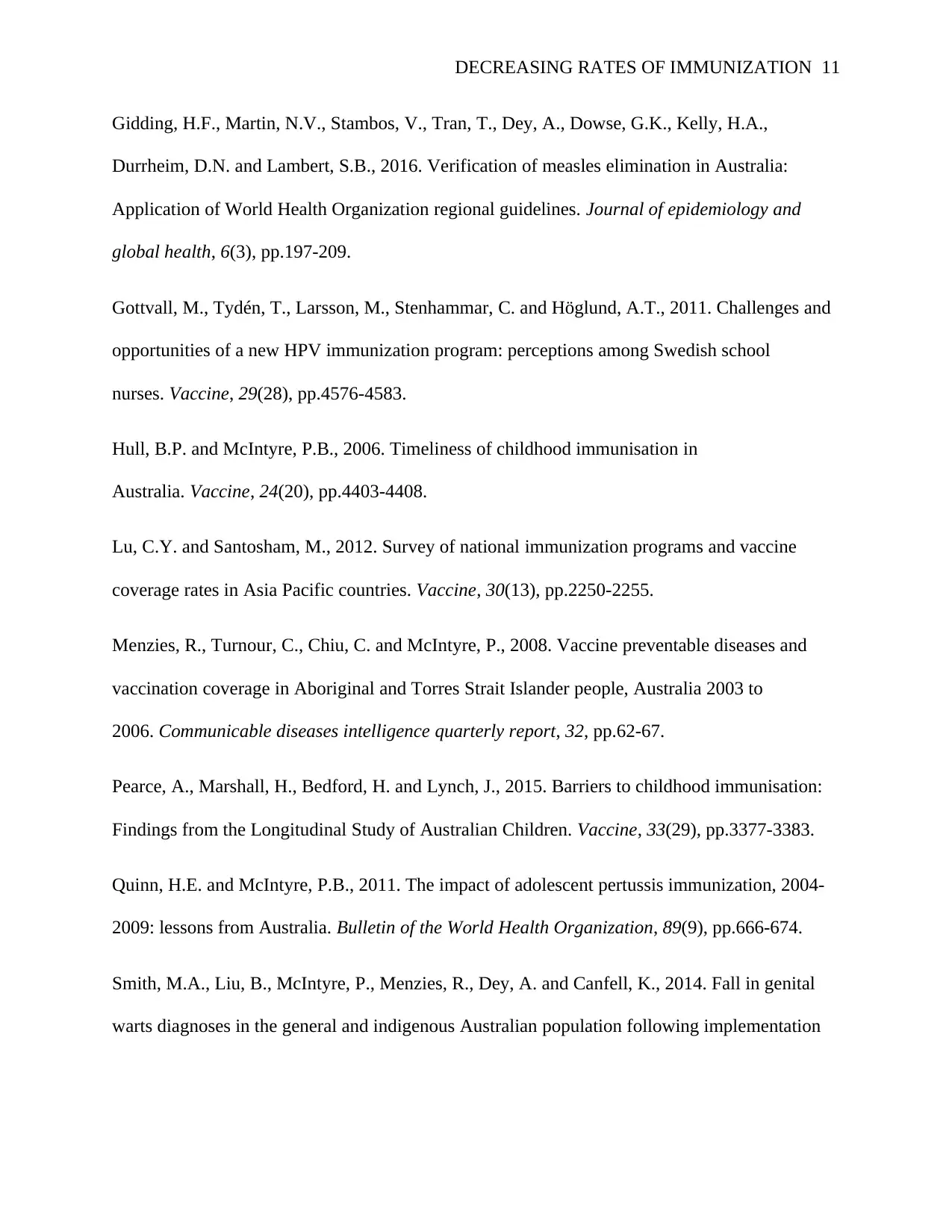
DECREASING RATES OF IMMUNIZATION 11
Gidding, H.F., Martin, N.V., Stambos, V., Tran, T., Dey, A., Dowse, G.K., Kelly, H.A.,
Durrheim, D.N. and Lambert, S.B., 2016. Verification of measles elimination in Australia:
Application of World Health Organization regional guidelines. Journal of epidemiology and
global health, 6(3), pp.197-209.
Gottvall, M., Tydén, T., Larsson, M., Stenhammar, C. and Höglund, A.T., 2011. Challenges and
opportunities of a new HPV immunization program: perceptions among Swedish school
nurses. Vaccine, 29(28), pp.4576-4583.
Hull, B.P. and McIntyre, P.B., 2006. Timeliness of childhood immunisation in
Australia. Vaccine, 24(20), pp.4403-4408.
Lu, C.Y. and Santosham, M., 2012. Survey of national immunization programs and vaccine
coverage rates in Asia Pacific countries. Vaccine, 30(13), pp.2250-2255.
Menzies, R., Turnour, C., Chiu, C. and McIntyre, P., 2008. Vaccine preventable diseases and
vaccination coverage in Aboriginal and Torres Strait Islander people, Australia 2003 to
2006. Communicable diseases intelligence quarterly report, 32, pp.62-67.
Pearce, A., Marshall, H., Bedford, H. and Lynch, J., 2015. Barriers to childhood immunisation:
Findings from the Longitudinal Study of Australian Children. Vaccine, 33(29), pp.3377-3383.
Quinn, H.E. and McIntyre, P.B., 2011. The impact of adolescent pertussis immunization, 2004-
2009: lessons from Australia. Bulletin of the World Health Organization, 89(9), pp.666-674.
Smith, M.A., Liu, B., McIntyre, P., Menzies, R., Dey, A. and Canfell, K., 2014. Fall in genital
warts diagnoses in the general and indigenous Australian population following implementation
Gidding, H.F., Martin, N.V., Stambos, V., Tran, T., Dey, A., Dowse, G.K., Kelly, H.A.,
Durrheim, D.N. and Lambert, S.B., 2016. Verification of measles elimination in Australia:
Application of World Health Organization regional guidelines. Journal of epidemiology and
global health, 6(3), pp.197-209.
Gottvall, M., Tydén, T., Larsson, M., Stenhammar, C. and Höglund, A.T., 2011. Challenges and
opportunities of a new HPV immunization program: perceptions among Swedish school
nurses. Vaccine, 29(28), pp.4576-4583.
Hull, B.P. and McIntyre, P.B., 2006. Timeliness of childhood immunisation in
Australia. Vaccine, 24(20), pp.4403-4408.
Lu, C.Y. and Santosham, M., 2012. Survey of national immunization programs and vaccine
coverage rates in Asia Pacific countries. Vaccine, 30(13), pp.2250-2255.
Menzies, R., Turnour, C., Chiu, C. and McIntyre, P., 2008. Vaccine preventable diseases and
vaccination coverage in Aboriginal and Torres Strait Islander people, Australia 2003 to
2006. Communicable diseases intelligence quarterly report, 32, pp.62-67.
Pearce, A., Marshall, H., Bedford, H. and Lynch, J., 2015. Barriers to childhood immunisation:
Findings from the Longitudinal Study of Australian Children. Vaccine, 33(29), pp.3377-3383.
Quinn, H.E. and McIntyre, P.B., 2011. The impact of adolescent pertussis immunization, 2004-
2009: lessons from Australia. Bulletin of the World Health Organization, 89(9), pp.666-674.
Smith, M.A., Liu, B., McIntyre, P., Menzies, R., Dey, A. and Canfell, K., 2014. Fall in genital
warts diagnoses in the general and indigenous Australian population following implementation
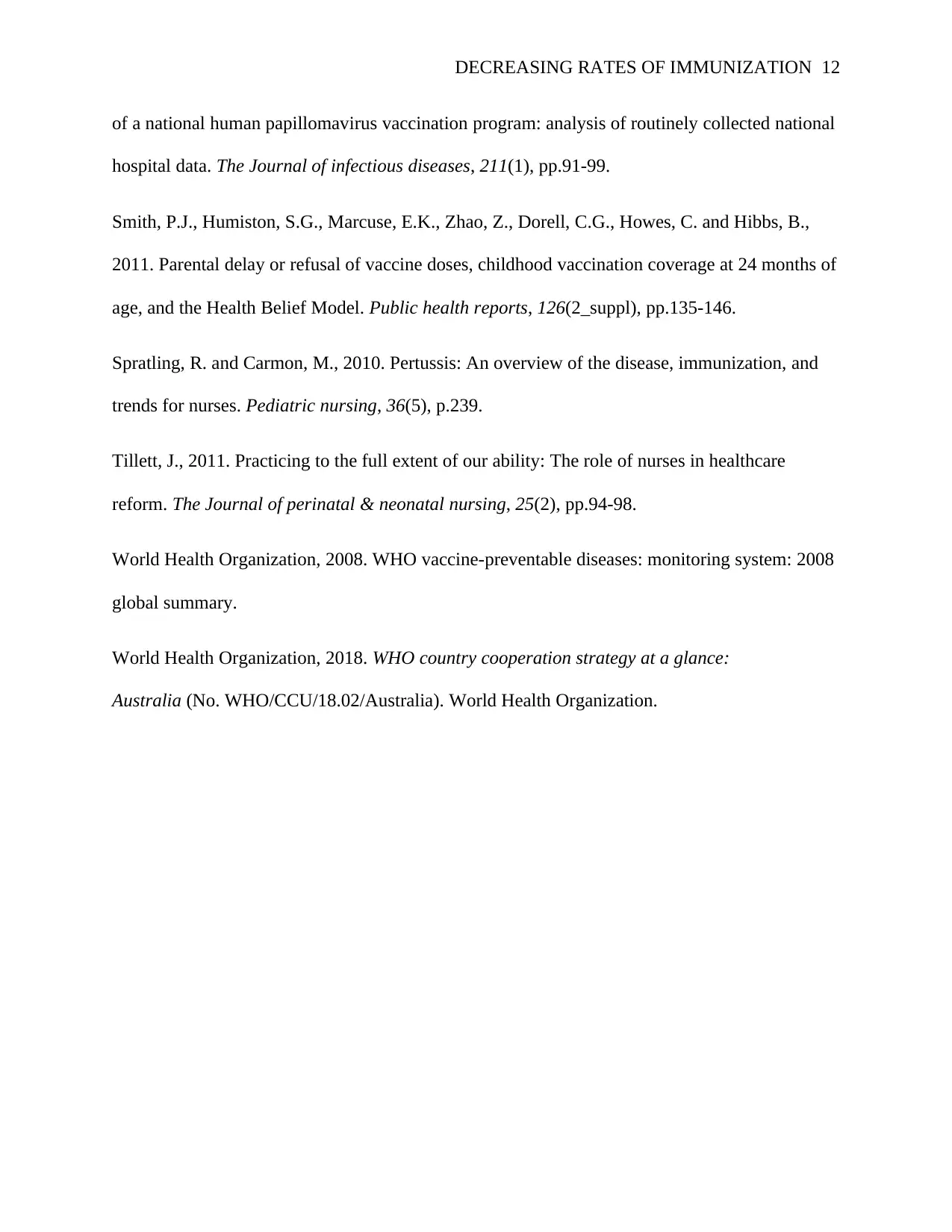
DECREASING RATES OF IMMUNIZATION 12
of a national human papillomavirus vaccination program: analysis of routinely collected national
hospital data. The Journal of infectious diseases, 211(1), pp.91-99.
Smith, P.J., Humiston, S.G., Marcuse, E.K., Zhao, Z., Dorell, C.G., Howes, C. and Hibbs, B.,
2011. Parental delay or refusal of vaccine doses, childhood vaccination coverage at 24 months of
age, and the Health Belief Model. Public health reports, 126(2_suppl), pp.135-146.
Spratling, R. and Carmon, M., 2010. Pertussis: An overview of the disease, immunization, and
trends for nurses. Pediatric nursing, 36(5), p.239.
Tillett, J., 2011. Practicing to the full extent of our ability: The role of nurses in healthcare
reform. The Journal of perinatal & neonatal nursing, 25(2), pp.94-98.
World Health Organization, 2008. WHO vaccine-preventable diseases: monitoring system: 2008
global summary.
World Health Organization, 2018. WHO country cooperation strategy at a glance:
Australia (No. WHO/CCU/18.02/Australia). World Health Organization.
of a national human papillomavirus vaccination program: analysis of routinely collected national
hospital data. The Journal of infectious diseases, 211(1), pp.91-99.
Smith, P.J., Humiston, S.G., Marcuse, E.K., Zhao, Z., Dorell, C.G., Howes, C. and Hibbs, B.,
2011. Parental delay or refusal of vaccine doses, childhood vaccination coverage at 24 months of
age, and the Health Belief Model. Public health reports, 126(2_suppl), pp.135-146.
Spratling, R. and Carmon, M., 2010. Pertussis: An overview of the disease, immunization, and
trends for nurses. Pediatric nursing, 36(5), p.239.
Tillett, J., 2011. Practicing to the full extent of our ability: The role of nurses in healthcare
reform. The Journal of perinatal & neonatal nursing, 25(2), pp.94-98.
World Health Organization, 2008. WHO vaccine-preventable diseases: monitoring system: 2008
global summary.
World Health Organization, 2018. WHO country cooperation strategy at a glance:
Australia (No. WHO/CCU/18.02/Australia). World Health Organization.
⊘ This is a preview!⊘
Do you want full access?
Subscribe today to unlock all pages.

Trusted by 1+ million students worldwide
1 out of 12
Related Documents
Your All-in-One AI-Powered Toolkit for Academic Success.
+13062052269
info@desklib.com
Available 24*7 on WhatsApp / Email
![[object Object]](/_next/static/media/star-bottom.7253800d.svg)
Unlock your academic potential
Copyright © 2020–2025 A2Z Services. All Rights Reserved. Developed and managed by ZUCOL.





